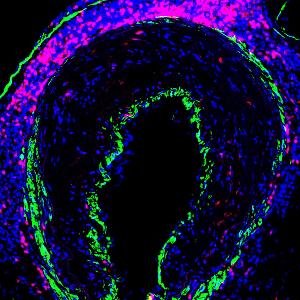T cells and atherosclerosis: the good, the bad, and the unknown
27 Feb 2023
LMU researchers have discovered that atherosclerosis leads to disorders of the immune system, similar to those in known autoimmune diseases.
27 Feb 2023
LMU researchers have discovered that atherosclerosis leads to disorders of the immune system, similar to those in known autoimmune diseases.

T cells (red) are recognizable in the inner plaque and in the outer wall layer. Smooth muscle cells are shown in green. | © Sarajo Mohanta / IPEK, LMU
Atherosclerosis is the most common pathological change in the walls of arteries. It can lead to dysfunctions of the endothelium, to inflammations, and to deposits in vascular walls. If such plaques constrict blood vessels, they can cause circulatory disorders. And if the plaques rupture and trigger blood clots, the patient can suffer a heart attack or stroke.
“Although T cells have been detected in atherosclerosis, immune tolerance dysfunction has remained unexplored as a disease driver,” says Professor Andreas Habenicht from the LMU Institute for Cardiovascular Prevention (IPEK). “Scientists have discussed the hypothesis that it could be an autoimmune disease for decades.
”Now a team led by Habenicht has managed to prove the conjecture with a mouse model of atherosclerosis, but also with data from human plaques. Other contributors to the paper in Nature Cardiovascular Research were LMU doctoral researcher Zhihua Wang as lead author, Prof. Changjun Yin from Sun Yat-sen University in Guangzhou, China, as senior author, and Professor Klaus Ley from Georgia Institute for Immunology in the United States. “In the paper, we show for the first time that, with a very high degree of probability, atherosclerosis in late, clinically relevant stages is a T lymphocyte-dependent autoimmune disease,” explains Habenicht. This applies, he adds, to all three major T lymphocyte subpopulations, namely to CD4, CD8, and regulatory T cells.
Habenicht and his colleagues investigated immune system checkpoints in a mouse model for atherosclerosis. They worked specifically with atherosclerotic plaques, with artery tertiary lymphoid organs – structures on the outside of diseased arteries – and with lymph nodes. “This was new; the T cell lymphocyte system had not previously received any major attention with regard to autoimmunity of atherosclerosis,” emphasizes Habenicht.
Their investigations showed that immune tolerance breaks down in various tissues in mice with atherosclerosis. This related to plaques for the main part. Immune tolerance is the essential mechanism whereby the body prevents unwanted immune responses to an antigen – in this case, the body’s own structures. If these mechanisms cease to work, this results in autoimmune responses, with immune cells attacking the body’s own tissues – in this case, the arteries.
The affected checkpoints include the clonal expansion of CD4, CD8, and regulatory T cells. Clonal expansion refers to the activation and subsequent proliferation of lymphocytes. Because T cells do not ordinarily proliferate, this points to disruptions of the tolerance checkpoints.
“The immune cells that become aggressive are antigen-specific CD8 T cells, which occur particularly in atherosclerotic plaques,” says Habenicht. “But we were also able to detect helpful, protecting cells – namely, regulatory T cells.” In plaques, however, the researchers found hardly any of these cells. The balance seems to be disturbed at this point. What remains unknown is the significance of CD4 cells in this interaction but there are hints from the previous work of Klaus Ley in Georgia.
Next, the researchers wanted to know whether mechanisms that are found in the mouse model also apply to humans with atherosclerosis. They retrieved genetic information on human plaques from databases and used an algorithm to compare it with data from the mouse model. There was a lot of concordance between the two sets of information: The CD8 tolerance dysfunction observed in the animal model also occurs in human coronary and carotid artery plaques. “Our data thus supports the concept of atherosclerosis as a bona fide T cell autoimmune disease that attacks arterial walls,” says Habenicht.
In the medium term, he envisages doctors intervening in checkpoints to treat atherosclerosis. There have been no causal therapies to date in this area. The general principle is known from cancer treatments. Checkpoint inhibitors are considered effective therapies that have already saved many human lives. However, the mechanisms are fundamentally different for cancer and atherosclerosis. “For this reason, we want to discover, in collaboration with Klaus Ley, which autoantigens are significant here,” says Habenicht.
Zhihua Wang, Xi Zhang, Shu Lu, Chuankai Zhang, Zhe Ma, Rui Su, Yuanfang Li, Ting Sun, Yutao Li, Mingyang Hong, Xinyi Deng, Mohammad Rafiee Monjezi, Michael Hristov, Sabine Steffens, Donato Santovito, Klaus Dornmair, Klaus Ley, Christian Weber, Sarajo K. Mohanta, Andreas J. R. Habenicht & Changjun Yin: Pairing of single-cell RNA analysis and T cell antigen receptor profiling indicates breakdown of T cell tolerance checkpoints in atherosclerosis. Nature Cardiovascular Research, 2023